2004 Four-Door Pickup Comparo
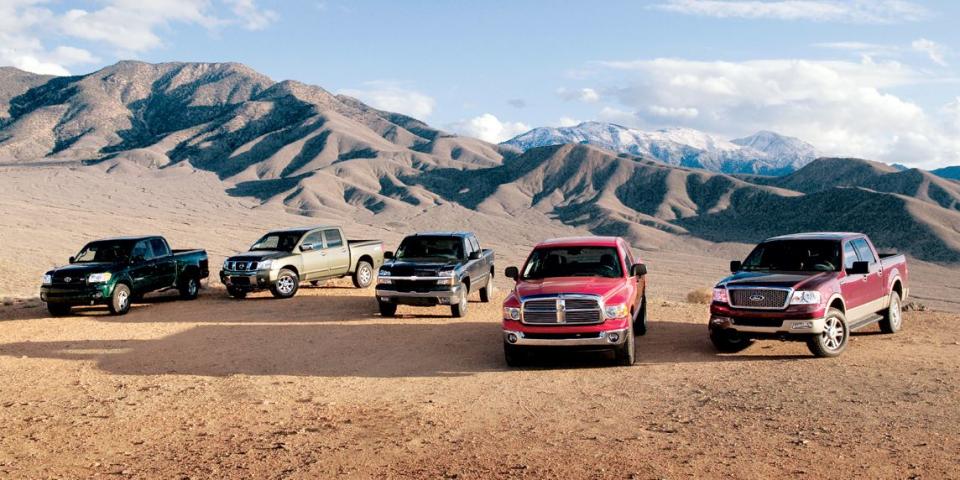
From the February 2004 issue of Car and Driver.
Should we call 'em Costco Cars? How about Bradley Shopping Vehicles? We're a nation of big appetites and high credit limits. We gotta get all that stuff home, then haul away the postconsumer jetsam. These big boys never say no to any civilian-size load.
Seriously, folks, consider the possibilities: one vehicle that will do it all. Life is short. Why make two trips? Bring yourself and four—or even five—carpoolers home from work and grab a month's worth of horse hay on the way.
Remember when four-door pickups were oddities? Railroad crews and oil drillers used them to pack sweaty guys into remote landscapes, but regular folk never gave them a second thought, except to pronounce them "monumentally misshapen." That was then, and this is a time of modern choices greased out the showroom door through the magic of 96-month paper. Drive your life style! Drive your dream! No limits! No fear!
No pain, either. This latest crop of full-size pickups, when stretched out to full two- row seating, are no-pain people movers.
Well, 11 to 13 mpg is not so painless, and parking them will intimidate pilots who never got comfortable with the world as shown in the side mirrors. But there are joys, too. Sitting way up there gives you the traffic-copter view, and strip-mall maneuvering is your chance to make Bimmers cringe.
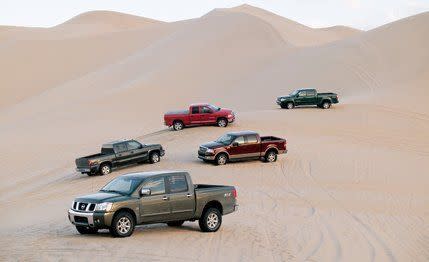
Model year 2004 is a big one for four-door trucks—two fresh-baked designs and two more that have been four-door-ized for the first time.
America's perennial bestselling model, the Ford F-150, is all-new this year after long-playing the old number since 1996. The Ford tracks the modern pickup evolution started by Dodge in 1994 with its Ram—bigger cab, smaller box, more life-style aids and comforts. More appealing looks, too, outside and in, because costume is now a big part of truck appeal. The F-150 is styled to look brawny yet leading-man handsome. From the outside, it pulls your eye as it passes.
All-new, too, is the Nissan Titan, as Japan's historically No. 2 automaker, long a trusted name in compact pickups, grabs for a share of America's rich market in full-sizers. Contrary to Toyota's approach—step by step up the size ladder until its Tundra is almost big—Nissan reared back and loosed "the Hulk." The Titan is high, wide, and aching for a showdown with all comers. Cab space tops all the others. It doesn't mess around with halfway engines, either: big horsepower is the only choice, 305 from an all-aluminum DOHC 32-valve V-8 backed by a five-speed automatic.
The light-duty Toyota Tundra and the Chevy Silverado are carry-over trucks that both get four-door cabs for the first time in 2004. The Tundra, like everything Toyota, has a silence and sophistication about it that makes it the Miss Manners of the truck world. It drives superbly—car guys can easily relate to it—but it doesn't swagger. That's a problem for truck buyers. So Toyota has muscled up the body to create the Tundra Double Cab. The front sheetmetal and certain body parts are brought over from the full-size Sequoia SUV. So the acreage of front iron is up, as is useful cab space. But the aura still says, "After you," in that cautious way. We'll see if that matters.
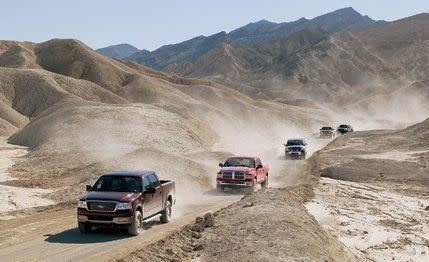
GM seems to be the last of the full-size makers to get the message that folks really do want four-door trucks. This Chevy is headed for a mid-2004 introduction. We got the first preproduction sample. Late, yes, but with good credentials—the Silverado has been a 5Best Trucks winner every year since we started those trials in July 2001.
These new models face off against the Dodge Ram, which is so much a believer in four-doors that it axed its extended cab in the 2002 redesign. Since then, two-door and four-door are your only Ram choices. Naturally, we asked for a Hemi.
That makes five new trucks, each with the largest available engine and four-wheel drive. We set up an epic trek across the gritty desolation of Death Valley. Last one to Costco has to haul the birdseed.
Costco Cars have one peril you might not have considered: parking. Truckers tell us stories of being trapped in their slots unable to angle out when other vehicles have crowded in too close on the sides.
These four-doors all have wheelbases stretched out to about 140 inches, at least a foot longer than that of a short-bed regular cab. That means wide turns, like a school bus. A hinge in the middle would help, or GM's optional Quadrasteer (rear steering).
Would some of our pickups be easier to park than others? We set up an intimidating test course, a straight-in slot barely more than 10 feet wide from a 21-foot aisle. It was bordered by real vehicles—not cones—so fenders were at risk, just as they are in real life, and protruding parts such as outside mirrors really mattered.
Here's what we learned. A good view out from the driver's seat counts more than small variations in length or width. Although the Silverado is longest, the small-looking Tundra takes the most parking space; the Toyota is wider and nearly as long yet is relatively easy to park. Its window sills and cowl are low. You can see down, in close to the Tundra's perimeter. Moreover, the gradual action of its accelerator enables inching motions at the bumpers.
The Silverado, for unexpected reasons, is the least handy. It has a jumpy throttle. The power-folding side mirrors don't pull in as tightly as the by-hand jobs on the others; we couldn't slip in as close to other trucks. And the automatic mirror-look-down feature in reverse is probably the wrong idea for a truck. Most often, clearance problems occur at the rear flanks: Look down, and you miss them.
All trucks make it tough to judge distance when backing toward low objects, like the nose of another car. The high horizon set up by the tailgate blocks the critical view. The high-riding F-150 seems worst in that regard, a problem not eased by the optional rear-parking-distance indicator ($245). It starts beeping far from other vehicles, not so far from posts. And it changes to a solid tone when there's still a foot of clearance to another vehicle. Give away a foot every time, and you make parking much harder than it needs to be.
Looking back, we conclude that parkability depends less on vehicle characteristics than driver personality. The most famously impatient of our staffers got about halfway into the slot on his first try and then aborted the whole venture, saying, "I'd just look for a bigger place." Our ex-New Yorker, having developed his technique watching the pros at the legendary Red Ball Garage, took to it like being back in the Majors. —PB
Fifth Place: Chevrolet Silverado 1500 Crew Cab
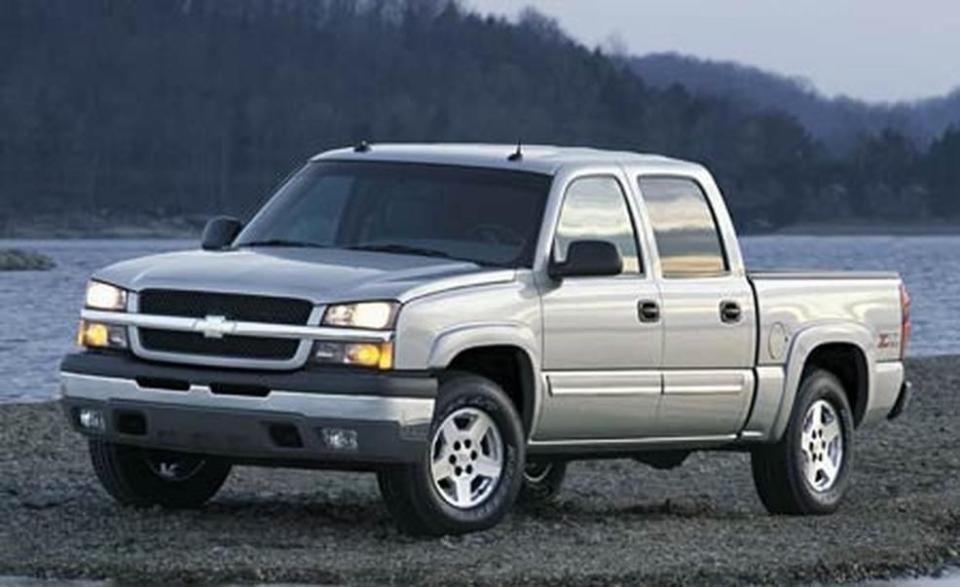
GM is not so good at knowing when to hold 'em and when to fold 'em. Its last-place showing in this test is a strong hint.
Yes, our Chevy was a preproduction sample, but only the four-door part; the rest is the senior citizen of the group, and the weaknesses we found are designed in. It scored last in eight of 22 rating categories, starting with driver comfort and ergonomics. It was last in styling and value, too.
The new part is the back seat, and it gets a midpack rating. The space is good for three adults across, but toes hit obstacles under the front seats and the tracks bite into Reebok room. The seat holds you a bit too upright, and the cushion is short. For cargo space instead of second-row seating, lift the cushion to tilt forward and fold the backrest down in its place, thereby creating a station-wagon-style load floor.
The front seats have a Barcalounger bulk about them and a softness that works against holding the driver in position. We didn't like the excessive spine curvature of the driving position, either. The aging dash is a haphazard landscape of unrelated shapes; it seemed good enough for a truck until the Ram, F-150, and Titan brought designer flair to the cockpit.
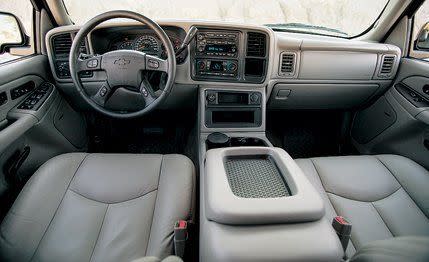
As for the Silverado's moves on the road, it takes us right back to the day when pickups were no fun. Steering and brake responses are indifferent. The ride is harsh even while being lackadaisical about control of body motions. The Vortec 5300, rated at 295 horses, is the only engine offered in this light-duty four-door. It's commendably silent at idle. Down the highway, though, you're always giving it the whip just to maintain speed on upgrades.
At the track, 0 to 60 happened in 8.8 seconds to tie the Toyota and show the tailgate to the Ford by half a second. Braking, at 206 feet from 70 mph, tied the Ford for last place; 0.67 on the skidpad was an undisputed last.
We like the clearly marked four-wheel-drive controls high on the dash, an easy left-hand reach away. When you press a button to order a change, you get a winking light, a sort of electronic affirmation that says, "Roger, wilco." We had only one mishap while cavorting in the sand of Death Valley's Dumont Dunes: The nose pitched down during a landing and popped a below-the-bumper fog light out of its mounting. Irrational exuberance in the driver seat gets some of the blame here.
Not so easily dismissed is the gear whine that was ever present after we left the dunes. Sand in the gears? All gear cases are carry-over equipment not subject to preproduction bothers.
The balloting was unanimous—fold it.
2004 Chevrolet Silverado 1500 Crew Cab
295-hp V-8, 4-speed automatic, 5420 lb
Base/as-tested price: $35,040/$39,7oo
C/D TEST RESULTS
60 mph: 8.8 sec
1/4 mile: 16.8 @ 84 mph
Payload: 2780 lb
Towing capacity: 7900 lb
C/D observed fuel economy: 13 mpg
Fourth Place: Toyota Tundra Double Cab
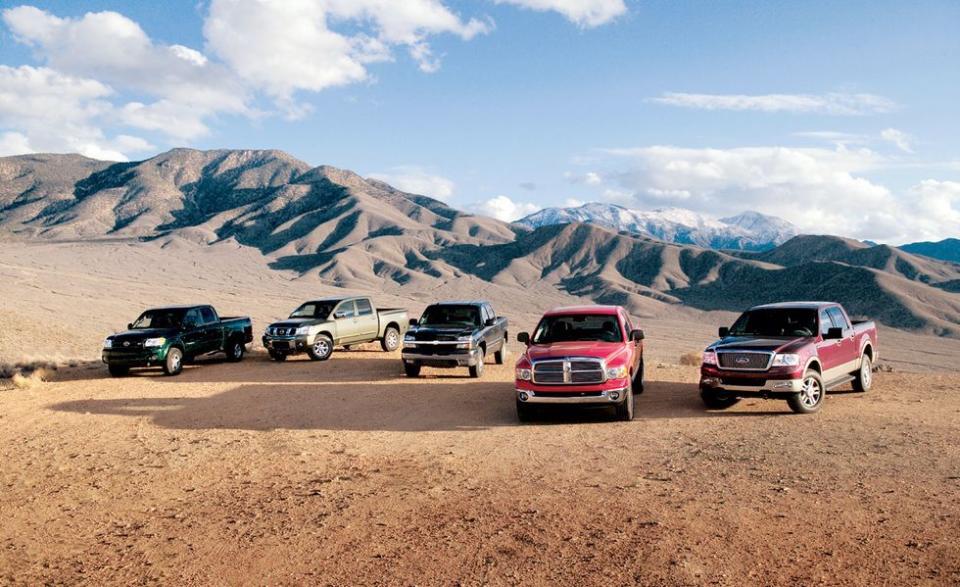
There was no unanimity on this one, except for a low "gotta have it" factor. None of us would belly-crawl through broken glass and burning gasoline to own this truck. Yet it drives like a well-oiled machine. It's wonderfully agile. And it fits people so well, with top-notch ratings for ergonomics and comfort, especially for back-seaters, where its friendly shape and genuinely plush surroundings say limousine. But these admirable virtues don't make for that insatiable longing in the gut.
Somehow, the Tundra is too much like kissing your sister.
If you line up the Double Cab with regular and extended-cab Tundras, you'll notice the four-door has a "big face." The cab is taller. There's more metal over the wheel openings. Yet it still looks small compared with other full-sizers. The taller roofline remains closer to the floor than in the others, meaning less cab space if you're hauling loose Wheat Chex or anything that fits in all the crannies. This contradicts the impression of occupants; they find it roomy in exactly the right places.
Along with the low roof, the Double Cab also has a low beltline, so the view out is better for maneuverability.
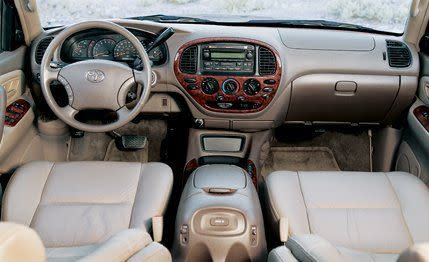
Surprisingly, considering its compact appearance, the bed length, at 74.3 inches, was longer than all but the Ram's.
Don't make too much of the fourth-place finish—second, third, and fourth were each separated by just a point. In addition to top marks in people friendliness, the Tundra earned top scores for ride and handling, fit and finish, and value. In acceleration, it's nip and tuck with the Chevy and outruns the heavy Ford. The engine makes a much more disciplined sound than those two, and the transmission is smarter about shift points. Skidpad grip and stopping distances were better than average.
The good view out made maneuvering on the tight trail of 20 Mule Team Canyon very secure. Ground clearance topped all others at 12.3 inches, a significant 1.7 inches over the next-best Chevy and a full 2.0 inches over the third-best Titan. Approach angle is very good in front, not so good to the rear, where the long bed hangs well behind the rear wheels. The Tundra has a high/low transfer case with part-time four-wheel drive and low range operated by switches on the dash. We had some difficulty getting low to engage.
A few features drew raves. The cab's electric rear-facing window is a convenient ventilation aid, and the huge sunroof opening provided a great opportunity for star gazing on the dark Death Valley nights—not while driving, of course.
"Nice" keeps coming to mind about the Tundra. Really nice, even. But that's not the same as lust.
2005 Toyota Tundra Double Cab
285-hp V-8, 4-speed automatic, 5160 lb
Base/as-tested price: $33,140/$36,433
C/D TEST RESULTS
60 mph: 8.8 sec
1/4 mile: 16.8 @ 83 mph
Payload: 1580 lb
Towing capacity: 6500 lb
C/D observed fuel economy: 13 mpg
Third Place: Dodge Ram 1500 Quad Cab
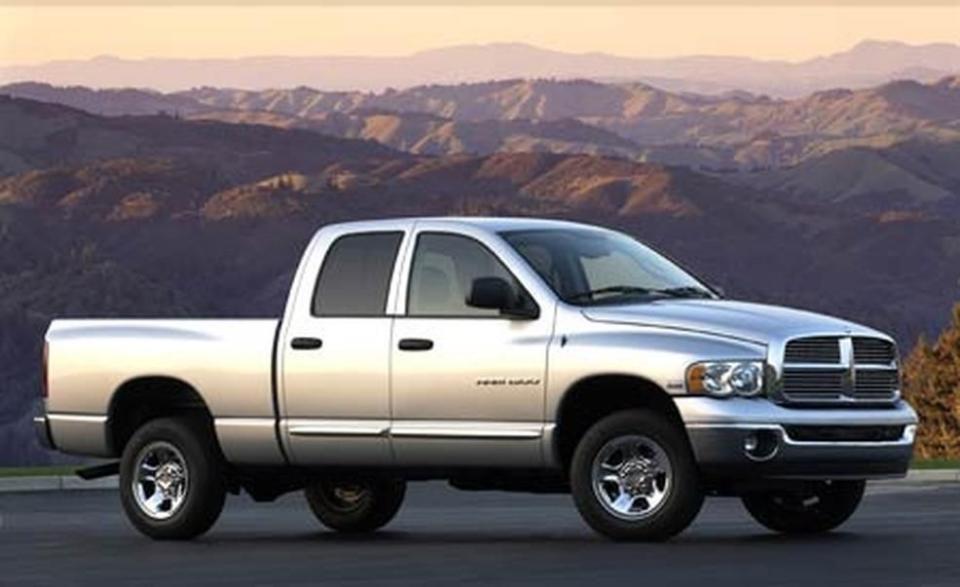
Never mind its midpack finish, squeezed tightly between the mannerly Tundra and the Hollywood-handsome F-150—there's nothing middling about the Ram. This Dodge is an in-your-face truck.
Get ready for extremes. The load bed is largest of the group, with the greatest length and the widest flat space between the wheel arches. The driving position is way up there, like its Freightliner cousins. The big wheels—"dubs" in street talk, 20-inchers wearing 275/60 Goodyear Wrangler HPs—have max swagger. And have you noticed the chrome badges just forward of the front wheel opening? "Hemi," they say; 345 horsepower, they mean.
Those who have to ask about "Hemi" won't understand the full glory of it. But they'll get picture enough the first time they boot the right pedal and hear the pagan howl. The Ram can't quite match the quick Nissan, but it easily opens daylight on the others: 0 to 60 in eight flat, clearing the quarter in 16.2 seconds at 86 mph.
The Ram is surprisingly agile for a big guy, best on the skidpad at 0.74 g, best in the lane change at 57.4 mph, tied for best in 30-to-50- and 50-to-70-mph passing.

It's also generous to drivers. Front-seat space shares the top ranking, and the cab is a masterpiece of convenience. You get seats and belts for six; the others are limited to five. The backrest of the center-front bucket folds forward to serve as a work table. And both the backrest and the cushion open to reveal mega-storage bins concealed within.
For rear passengers, the Ram is tighter than the others, and less comfy, but not so bad the crew will mutiny. Loading is easiest because the rear doors open to the widest angle.
For hauling cargo instead of people back there, the Ram zooms to the top of the class. The cushion tilts up theater-style, and there is a three-piece steel shelf (a $100 option) that folds forward to provide a flat floor and major headroom for packages.
Only the Ram has full-time four-wheel drive. Off-road, we got it grounded atop a Dumont dune, partly the result of driver caution over the crest. High-centering is an inherent problem for stretched trucks. For the record, though, the 9.5-inch ground clearance is second lowest of the bunch, and the front approach angle is worst.
The Ram brings three bags full of character to the driving experience; initially at least, about a third of it feels unfriendly. Everything you touch in the cab is hard. The brakes are overboosted. The steering feels too quick, yet after some familiarity, it was found to be remarkably accurate. The high hoodline blocks a lot of forward view. The ride, thanks to the dubs, is fairly rough.
The Ram is exactly what it appears to be—a hairy-chested truck.
2004 Dodge Ram 1500 Quad Cab
345-hp V-8, 6-speed automatic, 5600 lb
Base/as-tested price: $33,800/$40,635
C/D TEST RESULTS
60 mph: 8.0 sec
1/4 mile: 16.2 @ 86 mph
Payload: 1350 lb
Towing capacity: 7550 lb
C/D observed fuel economy: 11 mpg
Second Place: Ford F-150 Supercrew
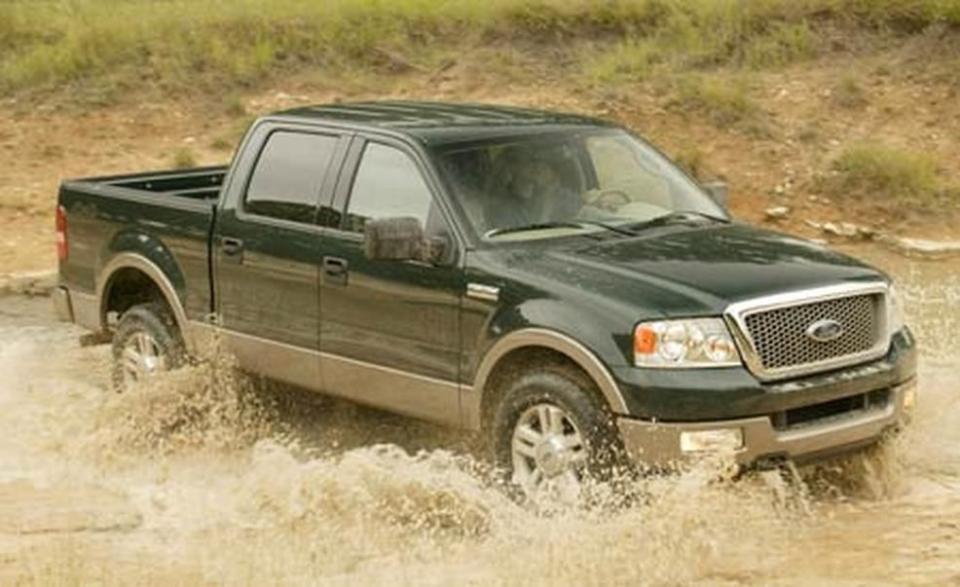
There's something presidential about this new F-150. It's smooth. It carries itself well. It has polish, and gravitas. Point it down a smooth highway, and you have the feeling of riding a throne.
It's a big step forward in American pickups. Ford had to ante up or lose its place at the top of the sales heap. GM has been cutting deals with Chevy and GMC models to keep the heat on. The Dodge Ram raised the bar for design and content again just a few years back. So Ford unrolled a huge investment to make an all-new truck with a fully boxed frame, a new three-valve 5.4 V-8, imposingly handsome sheetmetal, and a wowee interior. This mother looks expensive.
And it finishes second, off the podium by a full seven points, just one ahead of the Ram and two up on the Tundra. Uh-oh.
Worse yet, the buzz leaking from Ford speaks of major cost-cutting surgery. Will the throne turn into a plastic stack chair?
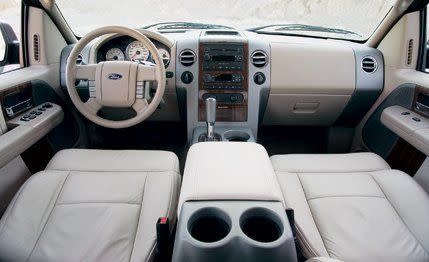
Probably not. This truck is immensely likable. The quality is unmistakable. The structure is solid. The interior is rich in detail. Example: The graining and gloss of interior materials, and the luster of metal trim pieces, are world-class. More: At night, the array of illuminated switches and dials spreads from one door panel across the steering wheel and dash to the other panel, and all but the window switches dim to a faint glow for dark-night driving. The adjustable climate-control vents in the dash feel like 20 bucks apiece. Driver comfort and ergonomics rank in a three-way tie for top marks. And the F-150 topped all the others in "features and amenities," even though the as-tested price was lower than those of both the Ram and Silverado.
Here's the rub: All this content shows on the scales—5960 pounds, 360 more than the brawny Ram and 800 more than the trim and agile Tundra. Even though our test truck packed the top engine, rated at 300 horsepower, it scored weak marks in every performance test. Zero to 60 measured 9.3 seconds, the quarter-mile was 17.0 seconds at 82 mph—both at the back of the pack.
For power users, the F-150 will be a disappointment. It tied with the Ram for worst fuel economy—at 11 mpg—on our test trip.
Yet there's a lot to like. You see quality everywhere. The plastic cladding over the wheel openings fits perfectly, with no molding to hide a misfit. The heavy tailgate is not a groaner, thanks to lifting assistance from a clever torsion-bar spring.
Rear-seat comfort bettered only the tighter confines of the Ram, but it's still very good, based on expectations set by past models.
For at least a few years, nothing will bump the F-150 from its top-seller perch.
2004 Ford F-150 Supercrew
300-hp V-8, 4-speed automatic, 5960 lb
Base/as-tested price: $36,925/$39,330
C/D TEST RESULTS
60 mph: 9.3 sec
1/4 mile: 17.0 @ 82 mph
Payload: 1550 lb
Towing capacity: 9200 lb
C/D observed fuel economy: 11 mpg
First Place: Nissan Titan SE Crew Cab
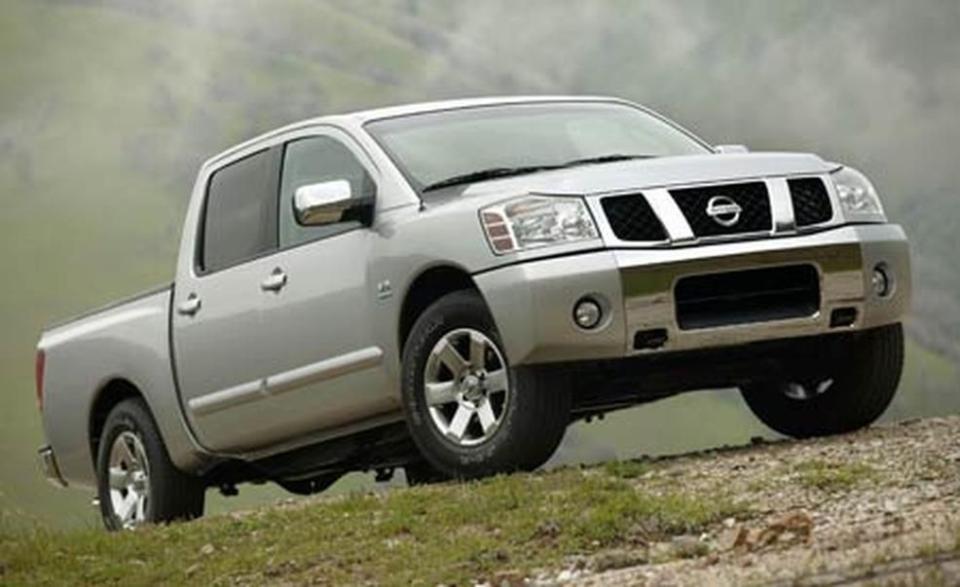
Who would've imagined a foreigner truck making its full-size debut and copping the prize? And doing it by a landslide margin of seven points!
Nissan didn't prep for a fistfight by getting a manicure. It made big V-8 power standard. It made the cab huge. It butched up the styling enough to leave no one thinking this was a wuss Japanese truck. And it hustled the extra mile to bring clever details that others surely thought of but decided they didn't need to be competitive. Finally, Nissan clamped a lid on price.
Heavy pickups never have too much acceleration. Shrewdly, the Titan is not heavy, only 120 pounds over the light-weight Tundra and well under all the Yanks. The all-aluminum V-8 outdisplaces all but the Hemi, and it's alive. In 0-to-60 runs, only the Titan breaks into the sevens (7.6 exactly). The Hemi ties in a few measures of acceleration, but the Nissan runs away from the others. Gas mileage on our trip was average at 12 mpg.
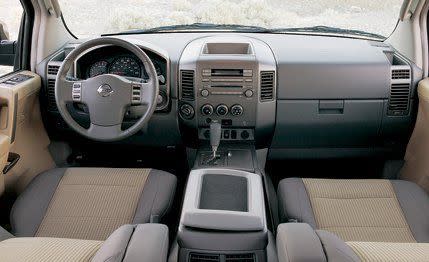
The cab fits the American truck ideal: high, with tall glass and chairlike front seats. Unlike the Detroiters, the Titan has a left-foot rest formed by a swell in the floor (the Tundra has a perfect dead pedal). Detroit offers nothing, apparently expecting you'll do the dining-room-chair position with your foot flat on the floor. Dash controls are placed high, easy to see and reach.
Styling inside and out is chunky and masculine, hardly handsome but full of attitude. On the road, there's much Pontiac-style "excitement." The throttle pedal has a jumpy action, and the slightest touch of it roars the exhaust. Want subtleties? If so, drive the F-150. Mostly, the Titan is not a ruffian for ride, but it finds all the jolts on L.A. freeways.
The big cab rates high for comfort, behind only the Tundra for rear passengers. We're impressed with the door-panel sculpting. You get well-positioned armrests that bend up into handy door pulls, plus the padding is carved away to make excellent knee clearance right where you want it.
Out back, the bed is among the shortest, measuring just 0.1 inch longer than the F-150's. The optional High-Utility Bed package ($900) includes nifty aluminum tracks on the three fixed sides of the box and lengthwise in the floor. Four beefy tie-down anchors can be adjusted anywhere you choose on the tracks. The package also includes a weather-sealed and lockable compartment carved into the outside unused space behind the left rear wheel.
Our test truck was light on options compared with the others —no leather—but the $30,450 base ducks under them by about three grand. At that money, the Titan will make friends fast.
2004 Nissan Titan SE Crew Cab
305-hp V-8, 5-speed automatic, 5280 lb
Base/as-tested price: $30,450/$33,670
C/D TEST RESULTS
60 mph: 7.6 sec
1/4 mile: 16.0 @ 86 mph
Payload: 1640 lb
Towing capacity: 9400 lb
C/D observed fuel economy: 12 mpg
You Might Also Like

 Yahoo Autos
Yahoo Autos 